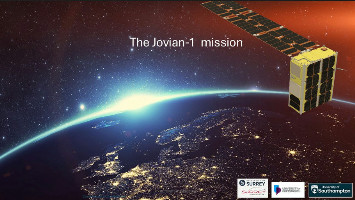| Name | Jovian-1 (FUNcube-Lite) |
|---|---|
| Form factor | CubeSat |
| Units or mass | 3U |
| Status | not launched, expected in 2026 |
| Launcher | not launched |
| Organization | University of Surrey |
| Institution | Company |
| Entity type | Commercial |
| Nation | UK |
| Partners | Surrey Space Centre |
| Oneliner |
Payloads include: camera to take images and videos; a FUNcube; elements of a future Dark Matter experiment; a space radiation monitor: a Tiny Machine Learning payload. |
| Description |
This will contain and power the five payloads being built by the University of Southampton, the University of Portsmouth, Surrey Space Centre at the University of Surrey, students from the three universities, and AMSAT UK. A collaboration between the universities of Surrey, Portsmouth and Southampton, JUPITER – the Joint Universities Programme for In-Orbit Training, Education and Research – will equip participants with invaluable hands-on space industry experience and training for their future careers. The satellite – Jovian-1 – will be around the size of a large shoe box and feature:
Inside these boxes are different pieces of flight hardware which will enable us to build Jovian-1 and prepare it for launch. As well as the main platform, we received the low rate S-band and the On-Board Computer, both of which are critical to the mission. The low rate S-band is the primary method the satellite will have of communicating with Earth. It was selected because it sends data using very little power. As anyone who listens in to operational meetings about satellite missions will tell you, it’s all about the power! The On-Board Computer will process information from each of the five payloads which will fly with Jovian-1, and it also receives instructions and updates from the ground station back on Earth ensuring the satellite can be orientated and controlled. This equipment will be unpacked, checked and housed in the clean room at Surrey Space Centre to ensure it isn’t contaminated by dust or grease. Then the Jovian-1 team will start testing to ensure good connections to the ground station and check that the software written by team members works and processes data. Meanwhile, work continues across the Space South Central region making each of the payloads. |
| Sources | [1] [2] [3] [4] |
| Photo sources | [1] [2] |
| COTS subsystems |
|
| Subsystems sources | [1] |
Last modified: 2025-04-26


